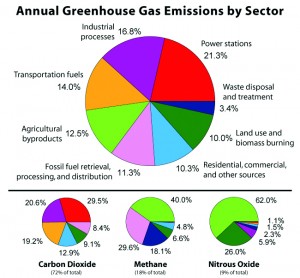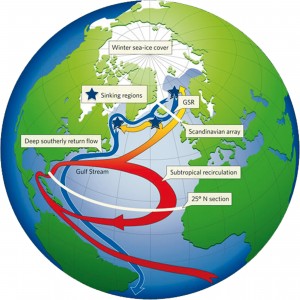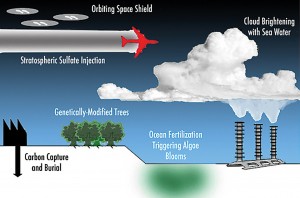Climate change
In just 200 years of industrialization, humankind has had a stronger influence on climate change than anything preceding it, reaching high up into the atmosphere and deep into the electromagnetic grid. The facts from the four pollution cycles are as terrible as the conclusion: the balance of the micro- and macrocosm of earth has been disrupted by mankind. This has led, in addition to the global environmental degradation, to climate change. But what does this buzzword actually mean for us? Industrialization and greenhouse gases lead to global warming; the poles are melting and the seas rising, which will lead to global cooling. All over the earth, average temperatures will fall by a few degrees, which will have even more devastating consequences than the preceding global warming, but let’s not get ahead of ourselves.
Global warming
The danger of modern times is the rapid rise in the average temperature of the atmosphere near the earth’s surface.
Between 1906 and 2004, the average air temperature near the ground only rose by 0.74° C. But the last decade was by far the warmest on record, with an average temperature rise of 0.36° C.
According to scientific extrapolations, the average temperatures will rise another 2° C by 2030. And by 2100, the temperatures will rise by between 4.8 and 6.4° C (estimates vary by source and the actual increase will depend on future greenhouse gas emissions and how the climate system reacts). A 2° C increase would be enough to trigger dramatic developments around the globe.
There are three significant causes of this dramatic temperature rise:
1. Global warming from industrialization and traffic
The largest influence is man and his destruction of the environment all over the globe by means of the four pollution cycles outlined above, all of which impact our health in many ways.
The man-made greenhouse effect arose at the beginning of the 20th century, primarily through the combustion of the fossil fuels coal, gas and oil. This combustion leads to an increase in the greenhouse gas carbon dioxide (CO2) and other toxic gases such as methane and nitrous oxide in the atmosphere. These gases change the atmosphere’s radiative force and cause less thermal radiation from the earth’s surface to reach space. This dramatic development is exacerbated by global deforestation and slash-and-burn practices and by agriculture and animal husbandry, of which the latter two emit more CO2 than all transportation. That is why laws and climate protocols have been designed in an attempt to reduce global warming to 2° C by 2100. But the so-called two-degree climate goal for avoiding the critical climate threshold, which has been accepted by around 100 countries, is already virtually out of reach because the international community cannot reach agreement in pursuit of this goal. Climate researchers warn that emission limits are the only solution, but the U.S. and China in particular are not cooperating and obstruct the rapid passage of laws or implementation of measures.
2. Global warming as a result of solar warming and solar storms
The second-largest influence on global warming is the temperature of the sun, as has been documented by recent scientific reports.
The sun exerts this influence through its cyclical movements of light and heat, its solar storms and its influence on magnetic fields and cloud formation.
The sunspots which are responsible for the solar storms are determined by the “average sunspot number”, whose value since 1940 has been higher than at any time in the previous thousand years and twice as high as the long-term average. In December 2012, according to NASA, solar storm activity reached its highest level, which has to do with the galactic conjunction, which we will examine more closely in a moment. The surface of the sun that is visible to humans is called the photosphere (see page 33), a 300-400-km-thick layer which is around 5,800 Kelvin (5,500° C) at the surface, but cannot “radiate”. Above the photosphere lies the almost invisible chromosphere, whose temperatures can rise to almost 10,000° C. Solar radiation, shock waves and other interactions heat the thinned corona material to unimaginable temperatures — up to two million degrees Celsius.
In the last ten years, these influences have accelerated warming of the earth’s climate from space, and electromagnetic eruptions have caused increasingly frequent, massive interference with power networks. The interior of the sun functions like a gigantic dynamo that transforms the kinetic energy of an electrical conductor into electrical energy and a magnetic field (similar to the geodynamo described on page 62).
These cycles and developments could increase average temperatures on earth by 0.4 to 1.3 degrees by 2024; 99.9% of the total energy absorbed by the earth’s climate comes from the sun, while only the tiny remainder comes from geothermal heat sources on our planet.
3. Global warming from galactic conjunctions and the photon ring
The third significant influence on global warming is the astronomical path of our solar system and the galactic conjunction that occurs every 26,000 years. These factors form the basis of the four-cycle calendar of the Mayas, the Vedas, astrology and the great pyramid in Giza, a cycle that ends and begins again during this decade.
These outward cycles bring our solar system nearer to the central sun of our galaxy, causing the temperatures of both the sun and the earth to rise slightly. The photon ring, which has an effect similar to the photon transfer between sun and earth that we have just seen, occurs in conjunction with every galactic conjunction. The galactic conjunction and the photon ring mark the turning points of the transitional period, which we will examine more closely in the next chapter.
Global cooling
Climate cooling as a result of ice melt
The most direct and extreme consequences of advanced global warming is the melting of the polar ice and glaciers, which causes sea levels to rise continuously, leading to world-wide flooding, changes in precipitation cycles and extreme weather.
The phenomenal, rapid global warming will cause almost complete melting of polar and glacial ice over the next 80 years, causing the Gulf Stream and overall earth temperatures to fall by 3-5° C. This, in turn, will lead to a “minor ice age” like the one in the 16th century, during which almost half of all crops failed. That also means that at the end of this century, some countries currently situated on the coasts of the continents will sink or lose a great deal of land; these include India and the island nations of the Pacific and in particular, Bangladesh. But European countries such as Holland will also be affected.
The consequences for the future life of humans and animals on Earth are inestimable.
Glacier melt
Since as early as 1960, a clear reduction in glaciers has been observed; this is called glacier melt. The Alpine glaciers lost about 35% of their area in the last 50 years.
A WWF report revealed that 67% of all Himalayan glaciers are melting away and in some areas there is warming at a rate five times that of the global average. The causes are the increased concentration of greenhouse gases and also of soot and other particulates that result from the burning of fossil fuels in China. These particulates absorb solar radiation, warming the air layer, which then rises. This accelerates glacier melt on the “roof of the world” even more.
Polar ice melt
Since 1980, the ice-covered area of the Arctic has shrunk, and the ice cover has been reduced by 8% each decade, or a total of about one quarter within about 30 years. The arctic surface, which is covered with snow at high altitudes in the spring, has been reduced by 18% over these three decades. In 2012, scientists showed that the Arctic ice is melting from the bottom as well.
The warming of the North Pole is proceeding more than twice as fast as the global average. While the earth has warmed by an average of 0.7° C since the Industrial Revolution, the Arctic region has warmed by almost 2° C. That is why polar melt has accelerated so that in less than ten years, ice has disappeared from an area the size of Western Europe.
Natural climate coolers
In addition to the undesirable polar and glacial melt, there are also natural climate coolers such as the Gulf Stream, the El Niño effect, clouds and volcanic eruptions. But their cooling effect is infinitesimal and does not last long.
Climate cooling by the Gulf Stream
The circulation of Gulf Stream in the Atlantic Ocean has the crucial function of distributing heat over the earth’s surface. Warmed in the Gulf of Mexico, it flows to Europe and then further north, where it splits into various branches.
The largest of these is the North Atlantic Current, which functions as Europe’s water heater, so to speak. The temperature change of the Gulf Stream has extreme consequences for climatic development all over the world. If polar melt and the rivers that drain Russia and the Alps continue to empty such great quantities of fresh water into the oceans, the Gulf Stream will stop flowing, resulting in climate cooling of 1 to 3° C, primarily affecting Europe.
El Niño and the Humboldt Current
The function of El Niño (Spanish for “Christ child” because the phenomenon arises around Christmas time) in the Pacific is much like that of the Gulf Stream in the Atlantic. Normally, the warm surface water off South America flows west towards Indonesia. But in December, the water temperature is 28° C off Indonesia and only 24° C off Peru because at that point on the coast of South America, the trade winds cause the cooler water from the Humboldt Current to rise from the depths of the ocean. This causes circulation as the layer of warm water flows from Southeast Asia to South America for three months. The El Niño effect continuously weakens the cooler Humboldt Current, which eventually, like the Gulf Stream, will stop completely. As a result, the surface water off Peru’s coast is warming so much that the upper water layer no longer mixes with the nutrient-rich deep water, leading to the depletion of plankton and the collapse of the food chain.
Climate cooling by clouds
The great cooling influence of cloud cover and its thickness was only discovered when Danish physicist Henrik Svensmark carried out practical experiments at the University of Helsingør in a cloud chamber in 1995. The chamber was invented by Charles Wilson at the beginning of the 20th century and allows atomic particles to become visible by leaving trails in supersaturated gas. Svensmark discovered that the entire atmosphere functions like the air in such a cloud chamber and that cosmic rays play a significant role in the formation of clouds. This discovery was a seismic shift in climatology; the total effect of clouds causes the earth to cool. A mere 3% reduction in cloud cover during high levels of solar activity would warm the earth’s surface by 0.8-1.7 watts per square meter.
Climate cooling by volcanic eruptions
As incredible as it may sound, large volcanic eruptions, such as the eruption of Pinatubo in the Philippines in 1991, could have a silver lining when it comes to global warming because sulfur and ash cause global cooling. The effects of that eruption were felt all over the world and caused the release of a huge amount of aerosols into the stratosphere, forming a global layer of fog containing sulfuric acid over the next few months. This, in turn, caused the world’s temperatures to fall by 0.6-0.8° C and increased ozone deterioration.
Climate cooling by geo-engineering
Now we come to the spectacularly high-tech solutions that have been proposed. This “technical cooling” of the earth has brought about a new branch of science called geo-engineering or climate engineering that is based partially on the natural climate cooling systems we have just examined. Michael Odenwald, whose critical article in “Focus” I highly recommend, did an excellent job of summarizing the 70-year run-up to this development:
“The first ideas originated in around 1945, though initially for other reasons. The U.S. military were considering how they might influence the weather. […] The computer pioneer John von Neumann came to the conclusion that weather modification is possible in principle, but that it required sophisticated computer models. The idea of creating artificial rain by spraying condensation nuclei into the clouds came about as a result. […]
The Soviets even developed megaprojects. They actually wanted to thaw their Arctic north in order to open the region economically. Either this was to be done using nuclear weapons or by blackening large areas with soot, which would then cause the ground to melt as it absorbed more sunlight. […]
When it was realized that the rapidly increasing carbon dioxide (CO2) emissions resulting from human economic growth could influence the climate, the megalomania really began. In 1965, an advisory group recommended that the U.S. government distribute highly reflective particles in the oceans to deflect more sunlight back into space. […]
As the warning signs of climate change have mounted, these proposals have been hotly debated and new ideas have been proposed.
Big power companies have been attempting to compress and deposit the exhaust gas from their fossil fuel power plants into the Earth, for example, into emptied natural gas fields. […] An American scientist even considered depositing lunar dust in certain positions in the orbit of the moon. There, the dust particles would clump into clouds, which would shield and cool the Earth once a month for 20 hours. […] However, most scientists oppose such mega-projects because the outcome of manipulating an extremely complex system we know so little about is uncertain.”
(Odenwald – VI.4)
More widely known and discussed since the turn of the millennium are these seven cooling-down projects, all of which are considered plausible:
– Artificial trees that absorb CO2
These CO2 scavengers, which were suggested by British researchers, are to be placed along highways and serve as advertising space.
– Clouds formed from salt water generated by pipe systems on the open ocean. Such clouds, proposed by engineer Stephen Salter, would reflect the sun’s radiation and reduce warming.
– Stir up the upper layers of the ocean to increase the amount of nutrients at the surface and stimulate algae growth. This idea was proposed by environmentalist James Lovelock, author of three fascinating books about GAIA and the climate, the fundamentals of which I largely agree with; I disagree only with his conclusion that we should invest in nuclear energy.
– Increase algae growth in the oceans by seeding them with tiny iron filings (iron fertilization). Algae absorb carbon dioxide during photosynthesis, reducing warming. When the algae die, they sink to the bottom of the ocean, carrying with them the CO2 and thus removing it from the system for a long time. This idea was proposed by geoscientists.
– Oceanification of the Sahara Desert in order to compensate for the rising levels of the earth’s oceans, which are being fed by melt water, and achieve a cooling effect with the increased water surface thus created. The Sahara is below sea level and a simple canal would transform the desert back into a sea, at the same time making North Africa fertile. The water from the Sahara Sea would evaporate and create rainclouds which would transform the surrounding half-desert from arid to fertile land.
– Introduce sulphur particles into the atmosphere and thus practically simulate the effects of a volcanic eruption in order to promote cloud formation. This idea was proposed by the climatologist Michail Budyko and optimized by Nobel Prize winner Paul Crutzen.
– Install solar sails made up of an estimated 16 trillion small, thin silicon plates about 60 cm in diameter in space between the Earth and the sun to create shade by reflecting enough sunlight back into space (Radiation Management) to greatly reduce global warming. These reflectors are to be packed into containers of one million plates each and fired into space with electromagnetic railguns. This idea was proposed by astronomer Roger Angel and physicist Lowell Wood.
– Put a ring of stone particles into orbit around the earth at an altitude of 1,300 km (much like Saturn’s rings). This plan would also require two monitoring moons whose gravitation would prevent the dissipation of the particles. These rings could remain in place for centuries and cool the Earth by up to 1.5 degrees. This idea was proposed by American researchers.
This is just a small excerpt from the book GAIA LEGACY.




